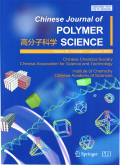- 钛学术文献服务平台 \
- 学术期刊 \
- 基础科学期刊 \
- 化学期刊 \
- 高分子科学(英文版)期刊 \
Preparation and Characterization of Attractive Poly(amino acid)Hydrogels Based on 2-Ureido-4[1H]-pyrimidinone
Preparation and Characterization of Attractive Poly(amino acid)Hydrogels Based on 2-Ureido-4[1H]-pyrimidinone
基本信息来源于合作网站,原文需代理用户跳转至来源网站获取
摘要:
Self-healing hydrogels with the shear-thinning property are novel injectable materials and are superior to traditional injectable hydrogels.The self-healing hydrogels based on 2-ureido-4[1H]-pyrimidinone(UPy)have recently received extensive attention due to their dynamic reversibility of UPy dimerization.However,generally,UPy-based self-healing hydrogels exhibit poor stability,cannot degrade in vivo and can hardly be excreted from the body,which considerably limit their bio-application.Here,using poly(l-glutamic acid)(PLGA)as biodegradable matrix,branching α-hydroxy-ω-amino poly(ethylene oxide)(HAPEO)as bridging molecule to introduce UPy,and ethyl acrylate polyethylene glycol(MAPEG)to introduce double bond,the hydrogel precursors(PMHU)are prepared.A library of the self-healing hydrogels has been achieved with well self-healable and shear-thinning properties.With the increase of MAPEG grafting ratio,the storage modulus of the self-healing hydrogels decreases.The self-healing hydrogels are stable in solution only for 6 h,hard to meet the requirements of tissue regeneration.Consequently,ultraviolet(UV)photo-crosslinking is involved to obtain the dual crosslinking hydrogels with enhanced mechanical properties and stability.When MAPEG grafting ratio is 35.5%,the dual crosslinking hydrogels can maintain the shape in phosphate-buffered saline solution(PBS)for at least 8 days.Loading with adipose-derived stem cell spheroids,the self-healing hydrogels are injected and self-heal to a whole,and then they are crosslinked in situ via UV-irradiation,obtaining the dual crosslinking hydrogels/cell spheroids complex with cell viability of 86.7%±6.0%,which demonstrates excellent injectability,subcutaneous gelatinization,and biocompatibility of hydrogels as cell carriers.The novel PMHU hydrogels crosslinked by quadruple hydrogen bonding and then dual photo-crosslinking of double bond are expected to be applied for minimal invasive surgery or therapies in tissue engineering.

推荐文章
微波辐射下4"-硝基-2-苯基-1H,1'H-2',5-双苯并咪唑的合成
4'-硝基-2-苯基-1H,1'H-2 ',5-双苯并咪唑
微波辐射
合成
3,4-二氢-1-(4-哌啶基)-2(1H)-喹啉酮的合成
3,4-二氢-1-(4-哌啶基)-2(1H)-喹啉酮
1-苄基-4-哌啶酮
苄胺
合成
微波辐射合成2"-硝基-2-苯基-1H,1'H-[2',5]-双苯并咪唑
2'-硝基-2-苯基-1H,1'H-[2',5]-双苯并咪唑
合成
微波
5-甲基-2(1H)吡啶酮的合成
5-甲基-2(1H)吡啶酮
重氮化
合成
内容分析
关键词云
关键词热度
相关文献总数
(/次)
(/年)
文献信息
| 篇名 | Preparation and Characterization of Attractive Poly(amino acid)Hydrogels Based on 2-Ureido-4[1H]-pyrimidinone | ||
| 来源期刊 | 高分子科学(英文版) | 学科 | |
| 关键词 | |||
| 年,卷(期) | 2021,(3) | 所属期刊栏目 | ARTICLES |
| 研究方向 | 页码范围 | 327-336 | |
| 页数 | 10页 | 分类号 | |
| 字数 | 语种 | 英文 | |
| DOI | |||
五维指标
引文网络
引文网络
二级参考文献 (155)
共引文献 (6)
参考文献 (33)
节点文献
引证文献 (0)
同被引文献 (0)
二级引证文献 (0)
1967(1)
- 参考文献(0)
- 二级参考文献(1)
1978(1)
- 参考文献(0)
- 二级参考文献(1)
1990(1)
- 参考文献(1)
- 二级参考文献(0)
1995(3)
- 参考文献(1)
- 二级参考文献(2)
1996(2)
- 参考文献(0)
- 二级参考文献(2)
1997(3)
- 参考文献(1)
- 二级参考文献(2)
1998(4)
- 参考文献(1)
- 二级参考文献(3)
1999(2)
- 参考文献(0)
- 二级参考文献(2)
2000(3)
- 参考文献(0)
- 二级参考文献(3)
2002(2)
- 参考文献(0)
- 二级参考文献(2)
2003(4)
- 参考文献(0)
- 二级参考文献(4)
2004(2)
- 参考文献(0)
- 二级参考文献(2)
2005(2)
- 参考文献(0)
- 二级参考文献(2)
2006(4)
- 参考文献(0)
- 二级参考文献(4)
2007(5)
- 参考文献(0)
- 二级参考文献(5)
2008(5)
- 参考文献(1)
- 二级参考文献(4)
2009(2)
- 参考文献(0)
- 二级参考文献(2)
2010(8)
- 参考文献(1)
- 二级参考文献(7)
2011(10)
- 参考文献(1)
- 二级参考文献(9)
2012(15)
- 参考文献(4)
- 二级参考文献(11)
2013(15)
- 参考文献(2)
- 二级参考文献(13)
2014(15)
- 参考文献(3)
- 二级参考文献(12)
2015(19)
- 参考文献(4)
- 二级参考文献(15)
2016(19)
- 参考文献(5)
- 二级参考文献(14)
2017(17)
- 参考文献(4)
- 二级参考文献(13)
2018(19)
- 参考文献(2)
- 二级参考文献(17)
2019(5)
- 参考文献(2)
- 二级参考文献(3)
2021(0)
- 参考文献(0)
- 二级参考文献(0)
- 引证文献(0)
- 二级引证文献(0)
引文网络交叉学科
相关学者/机构
期刊影响力
高分子科学(英文版)
主办单位:
中国化学会
中国科学院化学研究所
出版周期:
月刊
ISSN:
0256-7679
CN:
11-2015/O6
开本:
16开
出版地:
北京市中关村一街2号化学所院内
邮发代号:
创刊时间:
1983
语种:
eng
出版文献量(篇)
2840
总下载数(次)
0
总被引数(次)
6178
期刊文献
相关文献
推荐文献
- 期刊分类
- 期刊(年)
- 期刊(期)
- 期刊推荐
力学
化学
地球物理学
地质学
基础科学综合
大学学报
天文学
天文学、地球科学
数学
气象学
海洋学
物理学
生物学
生物科学
自然地理学和测绘学
自然科学总论
自然科学理论与方法
资源科学
非线性科学与系统科学
高分子科学(英文版)2022
高分子科学(英文版)2021
高分子科学(英文版)2020
高分子科学(英文版)2019
高分子科学(英文版)2018
高分子科学(英文版)2017
高分子科学(英文版)2016
高分子科学(英文版)2015
高分子科学(英文版)2014
高分子科学(英文版)2013
高分子科学(英文版)2012
高分子科学(英文版)2011
高分子科学(英文版)2010
高分子科学(英文版)2009
高分子科学(英文版)2008
高分子科学(英文版)2007
高分子科学(英文版)2006
高分子科学(英文版)2005
高分子科学(英文版)2004
高分子科学(英文版)2003
高分子科学(英文版)2002
高分子科学(英文版)2001
高分子科学(英文版)2000
高分子科学(英文版)1999
高分子科学(英文版)1998
高分子科学(英文版)2021年第9期
高分子科学(英文版)2021年第8期
高分子科学(英文版)2021年第7期
高分子科学(英文版)2021年第6期
高分子科学(英文版)2021年第5期
高分子科学(英文版)2021年第4期
高分子科学(英文版)2021年第3期
高分子科学(英文版)2021年第2期
高分子科学(英文版)2021年第10期
高分子科学(英文版)2021年第1期

 免费查重
免费查重










